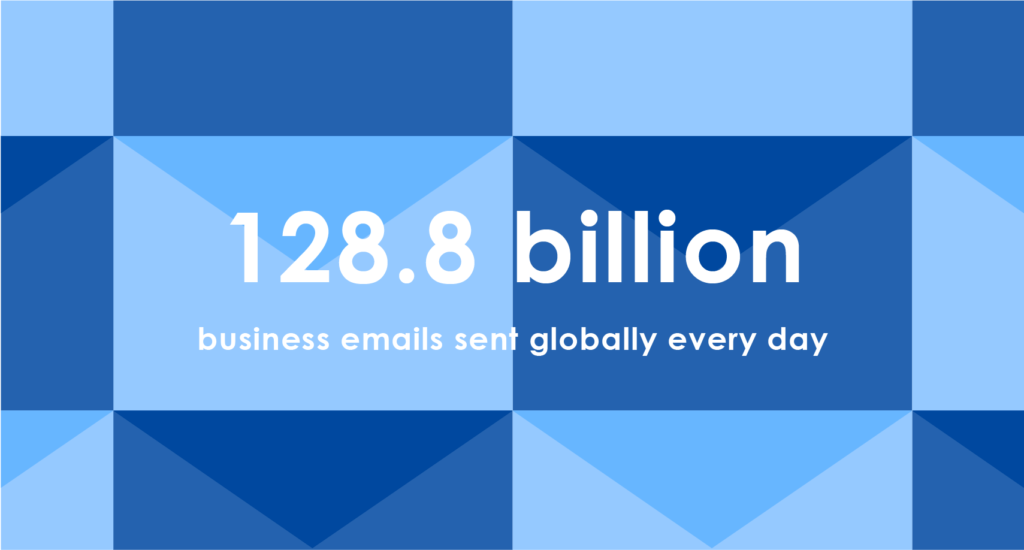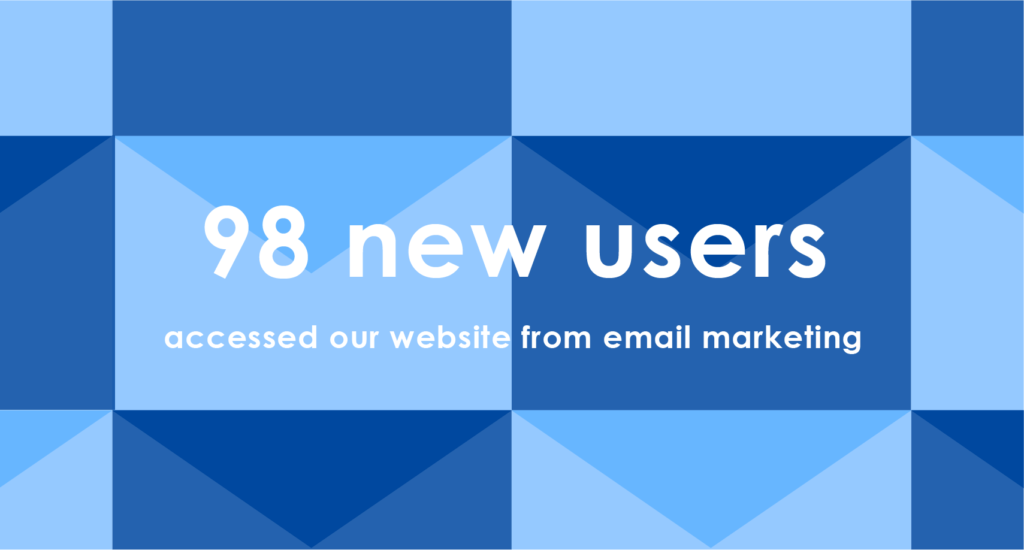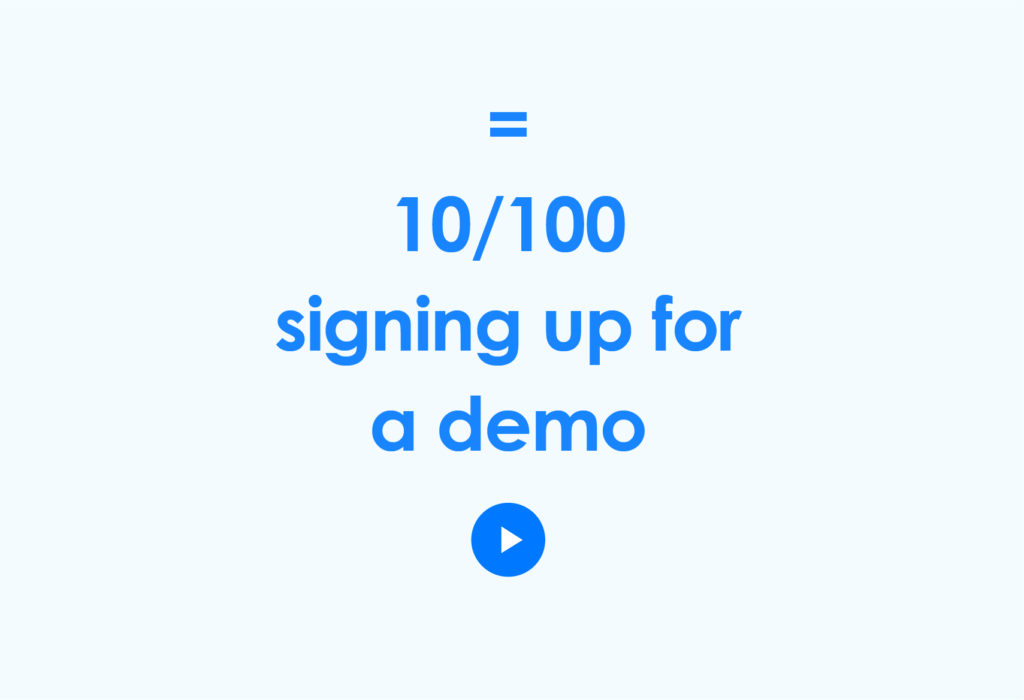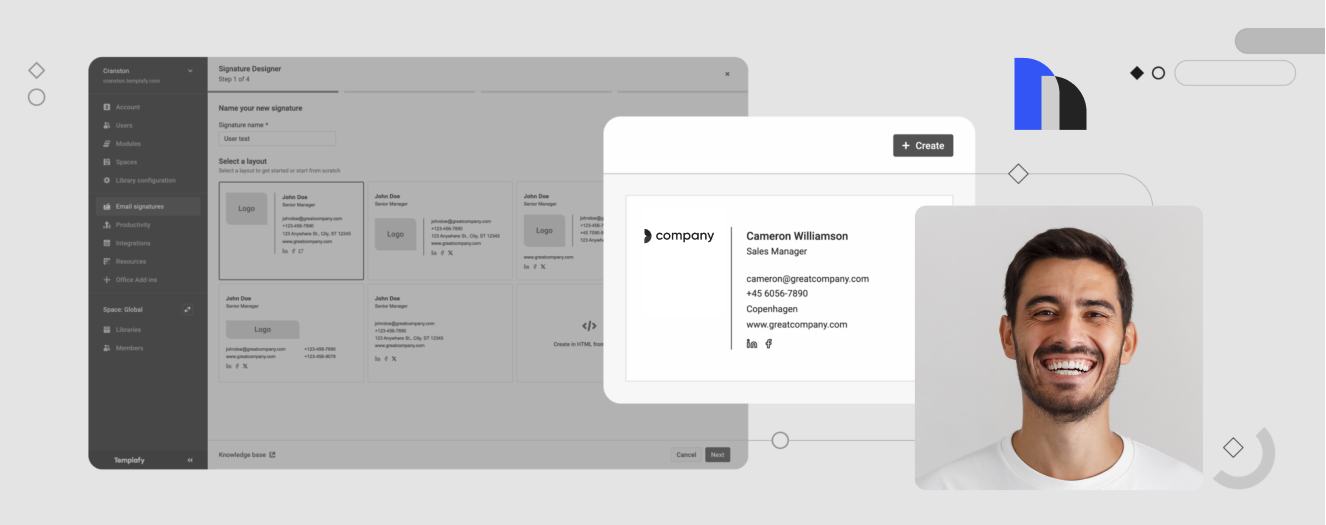Email signature marketing: everything you need to know

You might have heard the term ‘email signature marketing’ thrown around as an example of an effective marketing solution.
You might even have tried using email signatures as a marketing tool yourself. Whether you’re an email signature enthusiast, looking to improve your marketing efforts, or would just like to understand more about how email signatures work; we’ve compiled this blog to explain the potential email signature marketing has to offer your organization, based on our own data proving how beneficial email marketing can be.
What is email signature marketing?
Email signature marketing is as it sounds – the process of using the signature sent at the bottom of an email for marketing purposes, whether that is to promote a campaign, link to a video, or direct receivers to a CTA.
An email signature is the way in which an email is signed off, and commonly includes the name of the sender, job title and company, as well as sometimes including company information, such as address and contact details. There’s also potential to include details such as social media profiles, images and even videos, giving an invitation to connect and a way of advertising your latest content. Email signatures can be utilized for brand awareness, banner campaigns, department goals, sales strategies and more. Email signatures are low cost and reach a wide audience, making them an ideal marketing solution.

How can a mere email signature be such an effective marketing tool?
The answer is simple: the most impactful thing about an email signature is how many people it can reach.
Everyone sends emails. Everyone reads emails. In the workplace, emails have swiftly become the main form of business communication. Estimates on the number of emails sent each day suggest that by the end of 2019, over one third of the worldwide population will be using email.
In terms of numbers, this means that an average of 128.8 billion business emails will be sent per day We’re aware that when numbers get that big, they can’t quite be comprehended, so to make it clearer we’ve broken it down to relate to the average office worker: they receive 77 legitimate (non spam) emails per day, and send approximately 30 per day. That’s a huge number of emails.
Based on these statistics, it’s easy to see where the potential of email signature marketing lies. If your organization consists of just 10 people, there will be around 300 emails sent per day, and 1500 per week. That alone is no small number – but most organizations have many more than 10 employees. For an enterprise with 10,000 employees, that’s 300,000 emails per day and 1,500,000 per week, which adds up to over 1.5 million opportunities every single week to market your organization. Or, to put it another way, millions of missed opportunities every month if you’re not using email signature marketing.
Email signature marketing guide
Enterprise email signature that are secure and easy to implement
The numbers add up, but do people actually pay attention to email signatures?
If your organization is effectively utilizing email signature marketing, then email signatures will contain more information than just a name and job title, for example also including a video, a promotional banner, information about current offers, or specific campaign information. As the recipient is noticing who sent the email anyway, they are likely to pay attention to any surrounding information. Essentially, this offers a free way to advertise what your organization is already doing, and push important information to the right people.
An email signature is also a subtle way to create a brand impression. Every email carries a signature, even if it’s just the name of the sender. As the recipient reads, or just scans, the email, they notice who it’s from and the visual information surrounding this, and this information makes an impression. When this impression correlates with the image given by other brand communications, the brand and its associations are strengthened in the mind of the recipient.
The medium of email and its association with the professional workplace means the context in which an email is read can be predicted and controlled, enabling the signature to be tailored exactly to this. Due to the trust in corporate communications, recipients will be more responsive to the information they receive from corporate emails than from other forms of marketing. This all contributes to the effectiveness of email signature marketing, as the information contained in an email signature is noticeable, brand-centered and trustworthy.
Our data: can we prove that email signature marketing has an impact?
Before we go any further, we’d like to clear up some doubt – we don’t want you to just take our word that people pay attention to email signatures and that they are an important marketing tool. We want to show you why we know this to be true.
We’d heard that email signatures could be hugely impactful, and so we decided to put it to the test ourselves. We ran a split test, involving three groups of people in our own sales team. Each group had between 5 and 9 people, and tested a different email signature.
All the email signatures had a very similar design with banners which promoted the same report, offering the benefits of Templafy. Each of the three signatures focused on a different aspect of the report however, with one proclaiming a ‘< 3 month payback period with Templafy’, another highlighting a ‘30% productivity increase with Templafy’, and the final stating that ‘IT reclaimed 95% of its time’. All of the email signatures contained an image of the report and a call to action, which invited receivers to download the free guide.

Our data produced some interesting results:
- From the three email signature campaigns, there was a combined total of 98 new users, meaning that 98 people who had not accessed our website, and had no prior knowledge of our product or brand had willingly chosen to find out more based solely on the email signature they saw.
- A combined result of 222 sessions shows that recipients were not just visiting our site, but also browsing on it, meaning there was a large amount of interest generated in our website.
- This is supported by the result showing that session duration, or the amount of time spend on the page, was over two minutes, suggesting a high level of engagement and interest with the website content. For contrast, the session duration from an ad banner is normally around 30 seconds.
- Most importantly, there were conversions from this data, with 10 people out of 100 converting and signing up for a demo. Given the assumption that those receiving emails are already qualified, then this means qualified leads are converting, which are highly likely to generate customers.

Extrapolating this data to a larger enterprise situation where there are many more people sending emails with email signature campaigns means these already impressive results can become even more so. Where our data came from around 20 people, if data was instead from the email signatures of around 200 people (not an uncommon number for a large organization), the expected results would be 1000 people with no prior brand contact spending time on the website. This number of people using email signature marketing would also see 100 conversions, which could lead to 100 new customers. And all for the very simple price of implementing an email signature.
We know that this is a lot of data, and we’re not all data scientists, so it can begin to get confusing – but the overall picture is that email signatures are an incredibly effective marketing tool, which directly lead to more engagement with content and increased conversions.
It’s also important to note that the email signature rates stayed high for the duration of the campaign – our data showed a clear spike with the campaigns began, but this did not diminish over time, meaning showing that the simple implementation of an email signature can have long lasting beneficial effects for your organization.
How can email signatures be varied for maximum impact?
Although our data shows that email signatures have a huge impact, it also shows that not all email signatures are equal, because some of the versions performed better than others. This highlights how the effectiveness of an email signature is impacted by exactly how it is constructed, worded and the information it contains. Specifically, in order to get the most out of an email signature, it needs to be correctly targeted to the audience.
Email signatures can be specified based on user groups – practically speaking, this means different groups or departments of an organization can send different email signatures. A generic email signature will have an impact, but a specifically targeted email signature is able to have a far greater impact. Through targeting email signatures, maximum impact is achieved, and an audience receiving a message directly tailored to them is more likely to be responsive to this message. Through knowing and understanding the key ways in which departments work, the people they communicate with, and the best content to represent these elements, email signatures can be marketed accordingly.
Taking our example above, messaging focused on saving IT time would go to IT teams and heads of resources, where it would have the most impact. Similarly, HR departments can have email signatures containing links to job openings, sales departments can include information of current deals, and customer success teams can include links to customer stories, all of which showcase the department and provide helpful information to the recipients. Email signatures can also be used to aid department specific goals, for example links to webinars, conferences, or newsletter subscriptions that are relevant to different parts of the business. This shows the ability of email signature marketing as an internal tool – employees sending interdepartmental emails can let colleagues in other areas know what is happening in their part of the business.
Another vital point to note is that email signatures don’t have to be static or fixed, they can easily be changed or updated. This flexibility helps keep email signatures up to date, for example with season-specific banners, or information about a limited time promotion, or a job opening. With email signature software, it’s simple to update signatures, and have the updates rolled out to the relevant group immediately, meaning email signatures will always provide relevant information, enhancing their ability to produce a response.
How can email signature software help you get the most out of your email signature marketing?
Given that we’ve shown just how much impact email signature marketing can have, it wouldn’t be fair to leave you without some tips for how to get the most out of your email signature campaign.
Email signature software is technology which implements your email signature for all employees. This removes the errors which come from outdated email signatures or when email signatures are just copy and pasted off others. Through email signature technology, the correct designs and details are automatically implemented for all the individuals who need them, minimizing the risk of human error and increasing the marketing potential. Email signature software means that employees can be certain their email signatures will always be compliant, on-brand and up-to-date, so they can have the maximum impact.
Although email signature software implements the email signature, this email signature must first be designed. There are several design and practical points that should be taken into account when designing the signature, to help harness the potential of email signature marketing to the utmost.
What are the most important aspects of email signature design?
First and foremost in terms of design, email signatures are an opportunity to firmly center content in your brand. Practically, this means using the appropriate brand colors, font, logos and tone of voice. Doing this emphasizes the core brand values and shows recipients that your brand is at the center of every form of communication. A brand-rooted email signature will be far more effective than one which uses a different font, or incorrect colors, as this suggests the organization doesn’t particularly care about their emails or their brand.
Whilst the color theme should be aligned with the brand, it’s also important to not go overboard with this – just because your brand has multiple colors in its color scheme, this doesn’t mean that they should all be used in an email signature. Keep it mostly simple, but use a few touches of in-brand color for emphasis. Similarly, keep the fonts simple – feel free to use some variations such as bold and italic, but try not to use too much.
Secondly, it’s important to consider what elements are going to be most effective in an email signature. Although the potential offered by email signatures allows multiple elements to be added, it’s not wise to put all of these in, as it will create a cluttered and messy email signature, leaving recipients with no clear idea of what information they’re receiving. Information in the email signature should be as concise as possible, and only promote the most important elements. The information selected for the signature will vary depending on the organization and purpose of the signature, but it’s smart to consider what’s really important for your marketing at present. Should those receiving emails be directed to the social media account of the company, or encouraged to book a demo? This again emphasizes why it can be powerful to separate email signatures according to groups, because of the ability this provides to promote recipient-appropriate content.
Take note of the potential offered by icons – these can be used to host links, for example to social media sites. Icons have a clear meaning and simultaneously take up less space than a URL would, meaning they don’t clutter the email signature but still provide necessary information. It’s important to work with a designer to ensure that email signatures contain the important information, maintain a brand feel and are aesthetically pleasing.
A good best practice for creating an email signature is to plan it with a designer, being sure to consider the information it should contain, then create a template for the signature, ensuring that you have department-specific examples of signatures and appropriate legal disclaimers. Select a relevant campaign or piece of content to promote, or alternatively pick an achievement to celebrate. Finally, remember to include links that will enable the email signature to be tracked so that its impact can be assessed, and any necessary changes made.
What’s important to know when implementing an email signature for use?
Once the design has been decided, this needs to be implemented. Although implementation happens after the design process, it must be taken into account whilst the design is created, so the email signature can be easily implemented and used.
We spoke to our email signature implementation specialists and came up with a list of best practice tips that you should bear in mind whilst creating email signatures. When creating your own email signature, remember to consider:
- The conflicting nature of email providers: different organizations use different email signature providers – some use Outlook and some use Google. Alongside this, different web browsers have different allowances and support different formats. Although this doesn’t sound like a big difference, it means the html used to create emails will be interpreted differently between platforms, and this needs to be taken into account.
There are two important considerations that our implementation specialists recommend you take into account for this: firstly, ensure that the fonts used are websafe, meaning that they will display correctly in a multitude of different email providers. Secondly, remember that certain html formats work in some spaces and not others, and there is no generic email signature code. For example, if an organization builds emails in Outlook, styling and custom fonts shouldn’t be used, because these work in Outlook but not in web. Although not all web and email formats can be accommodated, you should try and accommodate as many as possible. Do your research thoroughly to see where emails are being sent from, and opened in, so that you’re not limited and don’t go to the trouble of creating an email signature which doesn’t have its potential realized. - It’s also necessary to be aware of which image formats are supported, for example, some providers support pngs, but not svgs, and vice versa. The same goes for transparency in images. Make sure that your logos and any images which appear are in a format that is supported by most providers.
- Use a unified metric system when designing and building an email signature. If you’re building it in pixels, make sure all information is in pixels, if you’re building in inches, make sure all the sizing is given in inches. This makes it easier to create, but also means that if the email is shifted to a new system, it’s easier to translate the email signature.
- UTM tracking codes can be set up in email campaigns. Businesses can track content performance metrics in UTM codes through using tracking systems such as Google Analytics, meaning the results of the campaign can be seen, and changes can be made based on performance. These are easy to add and provide important data, so should be included in the code of an email signature.
- Finally, as our data above showed, it’s always a good idea to test your email signatures. Don’t underestimate the value of A/B testing, which can provide helpful data relating to which signatures are more impactful. Through testing, analytics and old-fashioned trial and error, you can ensure email signature marketing is being used as effectively as possible.
How does Templafy’s Email Signature Manager work?
Email signature marketing software is a tool which provides huge benefits. Understanding the impact and benefits this can provide for organizations is one of the reasons why we developed Templafy’s email signature manager software. Through it, email signatures are applied company-wide without needing to send the emails to third-party servers, so security is maintained as everything is kept within the organization.
The email signature is based on a centralized administration system, meaning there is governance over the email signatures which employees are sending out, ensuring that the signatures are used for maximum impact. Templafy’s email signature manager also works through Active Directory groups, enabling the employee information in signatures to be kept up to date and allowing multiple user profiles for each employee. The option of multiple user profiles is especially important where employees work across multiple offices or countries, as it ensures the relevant language and legal disclaimers are always used.
Email signature marketing enhances marketing abilities across organizations, promotes your brand, and offers the potential for a huge return. It’s a tool that takes minimal effort and produces huge results. Promoting your organization has never been so easy – why don’t you try it out and see just how much benefit it can offer you?


